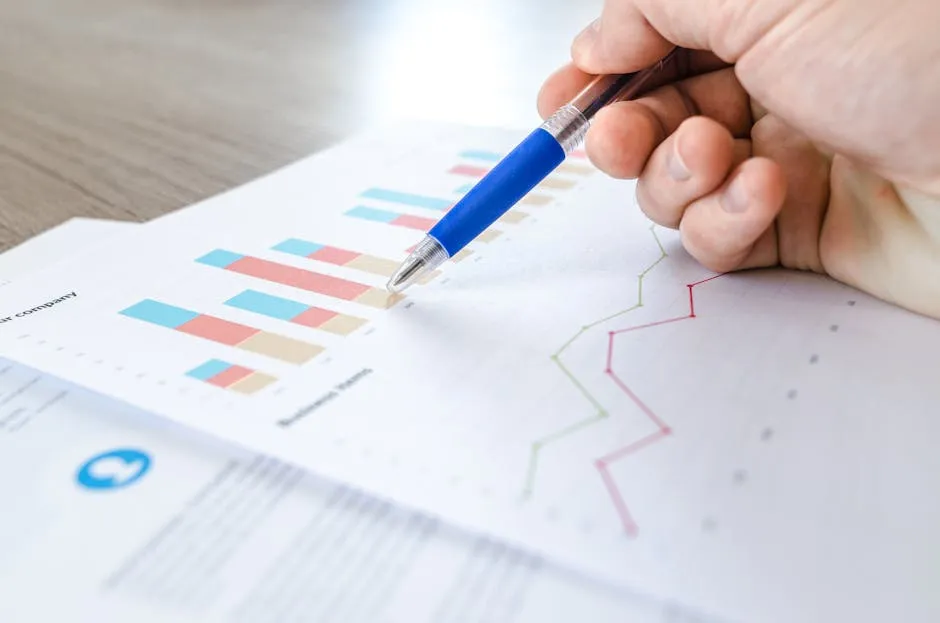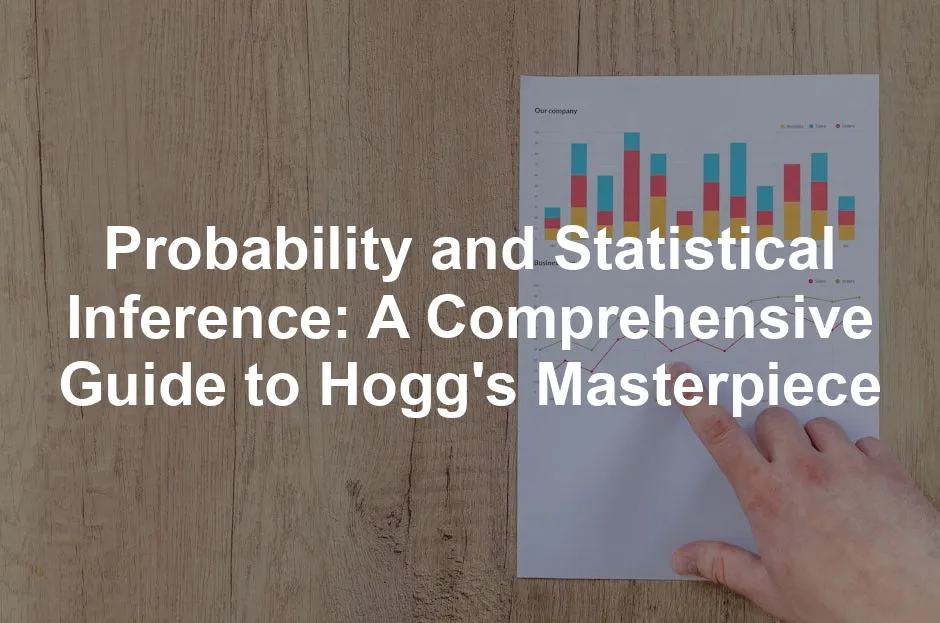Introduction
Welcome to the thrilling world of probability and statistics! If you ever thought math was just a series of numbers and equations, think again. Robert Hogg’s “Probability and Statistical Inference” transforms these concepts into fascinating insights. This masterpiece isn’t merely a textbook; it’s a gateway to understanding the unpredictable nature of our world.
Statistical analysis is crucial in today’s data-driven landscape. From predicting market trends to analyzing scientific phenomena, the demand for statistical knowledge is skyrocketing. Hogg’s book equips students with the necessary tools to navigate this complex field. It makes sense—after all, who wouldn’t want to make data-driven decisions?
The authors—Robert Hogg, Elliot Tanis, and Dale Zimmerman—bring their wealth of experience to the table. Their combined expertise offers an engaging and informative read. This book is particularly geared towards students with a solid calculus background. It provides a solid foundation for those brave enough to tackle the statistical frontier without a fear of numbers.
Speaking of tools, if you’re serious about diving into statistics, a reliable Scientific Calculator is a must-have. It’s like having a trusty sidekick that helps you tackle all those complex equations with ease!
With the rise of big data, understanding probability isn’t just helpful; it’s essential. Whether you’re a budding data scientist or a business analyst, grasping these concepts opens doors. So, buckle up! You’re about to embark on an enlightening journey through Hogg’s remarkable work.

Understanding Probability and Statistical Inference
What is Probability?
Probability is the science of uncertainty. Simply put, it quantifies how likely an event is to occur. Imagine flipping a coin. What are the chances it lands on heads? That’s probability at work! It’s a vital part of statistics, allowing us to make informed predictions based on available data.
Understanding probability is crucial for various reasons. First, it helps us interpret random phenomena. From weather forecasting to sports analytics, probability provides valuable insights. For instance, knowing the likelihood of rain can affect your plans for a picnic—so you better check the forecast!
In finance, probability plays a significant role. Investors use it to assess risks and returns. By forecasting market trends, they can make informed decisions. Similarly, scientists rely on probability to validate hypotheses. It provides a framework to draw conclusions from experimental data.
Let’s explore some real-world applications of probability. In healthcare, medical researchers use it to evaluate the effectiveness of new treatments. They conduct trials and analyze data to determine success rates. Probability helps them ascertain whether a treatment is worth pursuing.
In the realm of marketing, businesses analyze consumer behavior using probability models. Understanding purchasing patterns allows them to tailor their strategies effectively. For example, if a company knows there’s a 70% chance a customer will buy a specific product, it can allocate resources accordingly.
To further enhance your understanding, consider grabbing a copy of Statistics for Dummies. This book breaks down complex concepts into digestible bites, making it perfect for anyone looking to sharpen their statistical skills!
In summary, probability is more than just a concept; it’s a powerful tool that informs decision-making across diverse fields. As we dive deeper into Hogg’s “Probability and Statistical Inference,” you’ll uncover how these principles are intricately woven into the fabric of statistical inference. With this knowledge, you’ll be well-equipped to tackle challenges and make sense of the data that surrounds us.

The Role of Statistical Inference
Statistical inference is the magical art of drawing conclusions from data. Imagine you’re a detective, piecing together clues from a crime scene. You analyze the evidence to determine what likely occurred. Similarly, statistical inference helps us make sense of the randomness in data. Its purpose is straightforward: use sample data to infer properties about a larger population.
This process is vital in fields like economics, healthcare, and social sciences. In fact, without statistical inference, our decisions would be based on mere guesswork. Who wants to trust their fortune to chance? Not us!
There are two primary methods in statistical inference: point estimation and interval estimation. Point estimation provides a single value as a best guess for a population parameter. Think of it as throwing a dart at a board and hoping to hit the bullseye.
On the other hand, interval estimation gives a range of values, offering a more cautious approach. It’s like saying, “I’m pretty sure the target lies between these two points.” This method accounts for uncertainty, making it a safer bet for decision-making.
In summary, statistical inference is the backbone of data analysis. It transforms raw data into actionable insights, helping us navigate the complexities of the world with confidence and humor. Whether you’re assessing risks in finance or evaluating treatment outcomes in medicine, understanding statistical inference is invaluable.
Overview of Hogg’s Book
Authors and Their Expertise
Robert Hogg, Elliot Tanis, and Dale Zimmerman are the brilliant minds behind “Probability and Statistical Inference.” Let’s take a closer look at these statistical wizards.
Robert Hogg is a legendary figure in statistics. As a Professor Emeritus at the University of Iowa, he has influenced countless students. Known for his engaging teaching style, Hogg has authored over 70 research articles and co-authored several influential textbooks. His passion for statistics is infectious!
Elliot Tanis, a Professor Emeritus of Mathematics at Hope College, boasts a rich publication history. He’s received multiple teaching awards, proving that he knows how to make even the toughest concepts understandable. His commitment to education shines through in every page of Hogg’s book.
Dale Zimmerman, the Robert V. Hogg Professor in the Department of Statistics and Actuarial Science at the University of Iowa, brings expertise in applied statistics. His research and teaching have made significant contributions to the field. Together, these authors create a powerhouse of statistical knowledge.

Editions and Updates
Hogg’s book has evolved impressively through its various editions. The latest, the 10th edition, was published in 2024. This edition reflects current trends in statistical analysis and incorporates new examples and applications. It’s like giving the classic a fresh coat of paint while keeping its timeless essence.
The ISBN for the 10th edition is 978-1-292-45476-4 for print and 978-1-292-72307-5 for the e-book. You can snag a copy from major retailers like Pearson and Amazon, ensuring you have the latest insights at your fingertips.
Over the years, each edition has seen key updates. For instance, advancements in computing technology have shaped content, enhancing the relevance of examples used. This book is not just a dusty textbook; it’s a living document that grows with the field of statistics.
In summary, if you want to dive into the world of probability and statistical inference, Hogg’s masterpiece is the perfect guide. With its insightful authors and continual updates, you’ll find yourself well-equipped to tackle the statistical challenges of today’s data-driven landscape. An introduction to statistical learning with Python is a great resource to complement your learning.

Hogg’s book offers a solid foundation for understanding complex statistical concepts. Explore more about statistical learning with Python.
Key Concepts from the Book
Chapter Breakdown
Chapter 1: Probability
Welcome to the realm where uncertainty rules! Chapter 1 introduces the fascinating world of probability. Here, we tackle the properties of probability, which lay the groundwork for everything that follows. You’ll learn about enumeration methods—think of it as counting on your fingers, but with more flair.
Conditional probability deserves a gold star for its coolness. It helps us understand how the probability of one event changes when we know another event has occurred. Feeling curious? Bayes’ Theorem takes the spotlight. This gem allows you to update your beliefs based on new evidence. It’s like realizing your favorite pizza place is always crowded, so you adjust your dinner plans accordingly!
To bolster your probability skills, consider investing in a Graphing Calculator. It’s the perfect companion for visualizing those complicated functions and distributions!

Chapter 2: Discrete Distributions
Moving on, Chapter 2 focuses on discrete distributions. Here, we meet random variables—those quirky little creatures that can take on various values. You’ll discover the binomial distribution, perfect for situations where you have two outcomes, like flipping a coin. Heads or tails? It’s a classic!
Next up is the Poisson distribution. This one’s your go-to for counting events in a fixed interval, like how many customers walk into a café in an hour. Spoiler alert: it’s often used in fields like telecommunications and traffic flow. With these distributions, you’ll feel equipped to handle a variety of scenarios.
Chapter 3: Continuous Distributions
Chapter 3 dives into the smooth waters of continuous distributions. Here, we get cozy with the normal distribution—often called the bell curve. This distribution is significant in statistical inference and pops up everywhere, from heights to test scores.
Understanding the normal distribution is like having a secret decoder ring. It helps you interpret data and make predictions. You’ll also touch on other continuous distributions, like the exponential and gamma distributions. These distributions are handy when dealing with real-world phenomena that require a bit more complexity.

Chapter 4: Bivariate Distributions
In Chapter 4, we step into the world of bivariate distributions. This is where we assess relationships between two variables. The correlation coefficient takes center stage. It tells us how closely related two variables are, whether they’re dancing in perfect harmony or bumping into each other awkwardly.
You’ll learn to analyze data with techniques that help you visualize these relationships. It’s like being a detective, uncovering patterns in the chaos. Whether it’s height vs. weight or study time vs. grades, understanding these relationships can lead to impactful insights.
Chapters 5-9: Advanced Topics
Chapters 5 through 9 take a deeper plunge into advanced topics. You’ll explore point estimation, where you find a single value to estimate a population parameter. It’s like guessing the number of jellybeans in a jar, but with scientific backing!
Interval estimation follows, providing a range of values instead of a single guess. This method gives a buffer—like having a safety net while tightrope walking. Tests of statistical hypotheses come next, allowing you to put your theories to the test.
Advanced techniques like ANOVA (Analysis of Variance) make an appearance. ANOVA helps you compare means across multiple groups. It’s essential for experiments, ensuring your conclusions are valid and reliable.
With each chapter, Hogg builds your statistical toolkit. By the end, you’ll feel equipped to tackle real-world problems armed with knowledge and a dash of humor. So, grab your Measuring Up: How to Improve Your Measurement Skills and prepare to crunch some numbers!

Real-World Applications
Probability and statistical inference aren’t just academic concepts; they have practical applications that shape our everyday lives. Let’s take a look at some fascinating case studies that illustrate how these ideas manifest in the real world.
In healthcare, statistical inference plays a crucial role in evaluating treatment effectiveness. For instance, researchers conduct clinical trials to determine whether a new drug works better than existing options. They gather data from a sample of patients and apply statistical methods to infer the drug’s efficacy for the entire population. Without this process, medical professionals would be left guessing, and that’s a gamble no one wants to take when health is at stake!
Another compelling example can be found in business analytics. Companies use statistical models to analyze consumer behavior and improve marketing strategies. Take a retail chain that wants to know which products will fly off the shelves during holiday sales. By examining past sales data and applying probability theories, they can predict which items are likely to be popular. This helps them optimize inventory and avoid the dreaded “out of stock” situation when customers are eager to buy.

Moreover, in the realm of sports, teams leverage statistics to enhance performance. Coaches analyze player statistics to evaluate strengths and weaknesses. By understanding the probability of a player scoring under various conditions, they can make informed decisions on game strategies. This blend of data analysis and intuition creates a winning formula—quite literally!
These examples illustrate the power and influence of probability and statistical inference across various sectors. As we see, these concepts are not confined to textbooks; they’re vital tools that professionals use to make informed decisions every day. Sports statistics play a crucial role in this analysis.
Understanding sports statistics can greatly enhance team performance and strategy. Learn more about analyzing sports statistics.
Learning Outcomes and Benefits
Studying “Probability and Statistical Inference” by Hogg, Tanis, and Zimmerman equips students with invaluable skills. It’s not just about crunching numbers—it’s about developing a mindset. Here’s what you can expect to gain from this educational journey.
First and foremost, data analysis skills are paramount. You’ll learn how to handle data effectively, interpret results, and draw meaningful conclusions. This ability is essential in any field that relies on data, from business to healthcare. Employers highly value individuals who can sift through data and extract insights that drive decisions.
Critical thinking is another crucial skill fostered by this book. You’ll be trained to question assumptions, evaluate evidence, and consider alternative explanations. In a world where misinformation can spread like wildfire, having a critical eye is more important than ever. You’ll learn to differentiate between correlation and causation—an essential distinction that many overlook!
Statistical reasoning also emerges as a core benefit. You’ll grasp the principles behind statistical tests and how to apply them appropriately. This knowledge is invaluable in research settings, where making valid inferences is key. Whether you’re designing an experiment or conducting surveys, understanding statistical reasoning will set you apart.

Now, let’s talk career relevance. Mastering these concepts opens doors in various fields. In data science—a booming industry—statistical knowledge is a must-have. Companies seek professionals who can analyze data trends and help guide strategic decisions.
Finance is another sector where probability and statistical inference shine. Financial analysts use these skills to assess risk and forecast market behavior. Understanding statistical models can lead to better investment strategies and risk management.
Research positions, whether in academia or industry, also highly regard these skills. The ability to conduct rigorous statistical analyses is critical for producing credible research. You’ll become the go-to person for interpreting data and making sense of complex findings.
In conclusion, studying “Probability and Statistical Inference” isn’t just about learning theory; it’s about gaining practical skills that enhance career prospects. From data analysis to critical thinking, the benefits are both extensive and applicable across many professions. So, whether you’re eyeing a role in data science, finance, or research, this book will equip you with the tools you need to succeed in a data-driven world.
Conclusion
In the vast landscape of data analysis, understanding “Probability and Statistical Inference” is like having a map in a treasure hunt. It’s not just about numbers; it’s about making sense of the randomness around us. Robert Hogg’s book stands as a beacon for students eager to grasp these statistical concepts. By providing a solid foundation in probability and inference, it empowers readers to approach real-world data with confidence.
This book is essential for those venturing into fields like finance, healthcare, and social sciences. With statistical analysis increasingly influencing decision-making processes, equipping oneself with these skills has never been more crucial. Hogg’s text emphasizes the importance of variation in data, an essential concept that helps students understand the unpredictable nature of real-life scenarios.
By exploring concepts like conditional probability and statistical hypotheses, readers gain insights that transcend the classroom. They learn to apply theoretical knowledge to practical situations, enhancing their analytical capabilities. The engaging prose and real-world examples make even the most complex ideas approachable, turning what could be dry material into a lively discussion.
In essence, Hogg’s “Probability and Statistical Inference” is not just a textbook; it’s a comprehensive guide that nurtures critical thinking and analytical skills. As data continues to play a pivotal role in our lives, being well-versed in these concepts will set students apart in the job market.
So, if you’re ready to unlock the mysteries of data and enhance your statistical prowess, don’t hesitate! Grab a copy of Hogg’s masterpiece and start your journey into the fascinating world of probability and statistical inference. This book is your ticket to understanding the intricate dance of data, where every figure tells a story waiting to be uncovered.
FAQs
What is the target audience for Hogg’s book?
Hogg’s “Probability and Statistical Inference” is tailored for students with a calculus background. It’s perfect for those who have dabbled in math and are now ready to take the plunge into statistics. While previous knowledge of probability or statistics isn’t required, a firm grasp of calculus will greatly enhance understanding. This book serves as an excellent resource for undergraduates or anyone looking to deepen their statistical knowledge.
How does this book compare to other statistics textbooks?
When comparing Hogg’s book to other statistics textbooks, its unique approach shines through. Many textbooks can feel dense and impenetrable, but Hogg’s writing is refreshingly engaging. The authors present complex ideas in an accessible manner, using humor and real-world examples to illustrate concepts. Furthermore, the integration of advanced topics alongside foundational concepts makes it suitable for both beginners and those looking to refine their skills. While some textbooks may focus solely on theory, Hogg emphasizes the application of statistical methods in real-life situations. This practical approach equips students with tools they can use immediately, making it a standout choice in the crowded field of statistics literature.
Are there online resources available for further learning?
Absolutely! Numerous online resources complement Hogg’s book. Students can find various online courses that align with the book’s material, offering structured guidance through the concepts of probability and statistical inference. Websites such as Coursera and edX host courses led by experienced instructors. Additionally, platforms like Khan Academy provide free resources that cover foundational topics in statistics. Forums like Stack Exchange and Reddit’s statistics community offer opportunities to engage with fellow learners, ask questions, and share insights. These platforms create a supportive environment for students seeking help or additional explanations.
What prerequisites are recommended for this book?
Before diving into Hogg’s “Probability and Statistical Inference,” students should have a solid understanding of calculus. The book leverages calculus-based concepts throughout its chapters, meaning familiarity with derivatives, integrals, and limits will be beneficial. While prior exposure to probability or statistics is not necessary, having a mathematical mindset will help students navigate the material more effectively. In summary, if you’re ready to tackle the world of statistics with a solid mathematical foundation, Hogg’s book is the perfect companion to guide you on your academic adventure.
Please let us know what you think about our content by leaving a comment down below!
Thank you for reading till here 🙂
All images from Pexels




